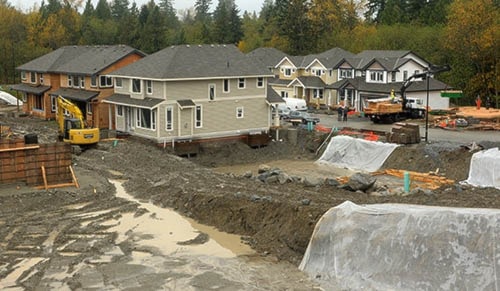Is it worth cramming in more apartments or townhouses and small lot homes if the district can scoop more money for libraries, parks and even a community centre?
Residents and developers continued the year-long discussion at an open house at Samuel Robertson Technical school Wednesday as council considers the concept for north Albion, near 240th Street and 108th Avenue.
Under a pilot project, developers of new subdivisions could be allowed higher population density zoning than originally set out in the official community plan.
While developers would reap the rewards of putting in more homes per hectare, they’d also have to pay half or three-quarters of the increase in the price of the property to the District of Maple Ridge.
The money then would be used for “amenities,” such as parks or trails or libraries or even a community centre.
Harold Murphy, though, has a simpler explanation of the concept.
“It’s blackmail. They’re going to take 50 to 75 per cent of the profit, then you’re going to get 25 per cent.
“To me, it’s just a rip-off.”
Murphy’s been living in Maple Ridge for 37 years and has two acres on 110th Avenue. He’s been thinking about subdividing for a few years, but may no longer do that. Other cities may use density bonusing, but they’re in more desirable areas, where developers want to locate, he said.
Brent Elliott, with CitySpaces Consulting, told a workshop at the open house that if council agrees to the concept, a formal policy would be written, clearly explaining the costs and the percentages so developers know the numbers before deciding to invest.
Most municipalities in the Lower Mainland charge for such density bonusing, with the norm being that cities take 50 to 75 per cent of the increased value through the amenity charges. That still leaves room for developer’s profit, Elliott added.
One home builder, though, worried that the concept of charging for increased density would apply any time a property was rezoned, even if the higher density had been previously outlined as a future use in the official community plan.
Wayne Jackson said he doesn’t mind paying a charge if the higher density wasn’t originally in the community plan, but not if a future property was always intended to have a certain population density.
“As a developer, I’m saying that’s not fair – because that’s the direction they’re moving.”
The open house is the second held by the district, after a previous event last May.
Staff will write a report to council outlining the options.
A staff report from last year suggested adding two new densities to the area, one that would see 48 lots measuring about 4,200 sq. feet, instead of 30 lots that are about 6,000 sq. feet, on a seven-acre parcel.
And instead of another area the same size having only 12 half-acre lots, there would be 30 lots a third of that size at about 7,000 sq. feet, with both areas creating 1,250 homes instead of the 1,000 set in the OCP.
The reported noted that 61 per cent of written responses opposed the slight increase in zoning, although staff later said most people at the meeting wouldn’t mind having a higher population density.
Maple Ridge’s population grew 10 per cent to 76,052 between 2006 and 2011.
That growth is expected to continue and to continue to put more pressure on the municipality for community services.
